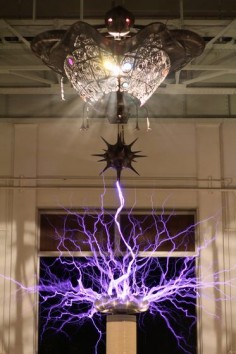YANOBE KENJI
ヤノベケンジ
mythos
source: yanobe
闇の中、水球を抱いた龍がおぼろげに”ある物語”を投影している。辺りは静寂に包まれ、鉄骨やコンクリートの瓦礫が散在し、埃と塵で空気は乾き、閑散とした廃墟である。点在する光の粒を追ってゆくと、シールドをかぶった《ランプ猫》たちが、その眼で暗がりを照らし出し彷徨っている。導水管の奥には、明滅する小さな太陽を手にした《ぬすっとマウス》。
水球を抱いた龍《幻燈夜会―有隣荘》が映し出すのは、2010年春に終成された「トらやんの大冒険」の物語である。1997年《アトムスーツ》を着たヤノベがチェルノブイリの荒廃した保育園で拾い上げた《人形》には魂が宿り、やがて歩き出し《トらやん》となって大阪の地に降り立ち、《ラッキードラゴン》(第五福竜丸)をも水の上をゆく船として再生させていったという、世紀をまたいで現実に起こったまさに夢のようなアートプロジェクトのストーリーである。 ギリシャ語で「物語・神話」を意味する『MYTHOS』と名付けられた本展で、ヤノべは自らの力では制御不能な自然現象の数々を取り入れ、創造を超えた先にある世界、超現実とも言うべき次元へと踏み出した。
ヤノべケンジの誇大妄想的な世界観は、常に「未来の廃墟」から始まってゆく。
誕生とは、壮絶であるが故に美しい。『MYTHOS』第1章は、鮮烈な光の柱が立ち上り、空気を切り裂く轟音が響き渡る「放電」により始まった。
水に覆われた廃墟の中心に聳え立つのは人工の稲妻発生装置・テスラコイルである。その真上には突起上のトゲを持つ《黒い太陽》と、呼吸するようにゆっくりと明暗を繰り返し、かつての「トらやんの大冒険」が透かし彫りにされた《亀ランプ》が浮かぶ。
ヤノベによる放電現象の作品化は《ウルトラ―黒い太陽》(2009)に続き、今回で2作目となる。また、初の構想はヴェネツィア・ビエンナーレ・日本館のために描いたものの実現しなかった幻のプランドローイング(2009)に見られて興味深い。過去の物語は影絵の幻影と化し、天地をつなぐ稲妻を誘引して浮揚する《黒い太陽》は一貫して謎めいた存在である。怪しげに漂うスモークが発せられ、あたかも雲間から稲妻が落ちてくる。創世記の第一章を想起させるかのような光景だが、それ以上に、天地が逆転した壮大な創造の風景の縮図が空間を凌駕し広がりを見せる。「放電」は、役目を終えた発電所跡の建物をも蘇らせる錯覚すら感じさせ、果てしない「再生」と生命誕生のエネルギーに満ちている。
.
.
.
.
.
.
.
.
source: azito-art
This exhibition place used to be an electric power plant. Yanobe will transform this abandoned building into the “future” place by creating a story and put it as an installation. In the “discharge” part, Yanobe set up a Tesla coil, which will generate an artificial thunderstorm and expressed as if the electric power plant revives.
.
.
.
.
.
.
.
source: azito-art
Born in 1965 in Osaka, Kenji Yanobe attended Kyoto City University of Arts and received a Master of Arts degree in 1991. Since the early 1990s, Yanobe has been incorporating the theme of survival in present-day society into his work, creating numerous large-scale mechanical sculptural works that may be attached to one’s body or ridden and controlled. With the dawning of the 21st century, Yanobe shifted to the theme of revival, and in 2003, he held the exhibition Megalomania, the culmination of his work up to that time, at The National Museum of Art, Osaka (on the site of Osaka Expo ‘70 world’s fair). In 2004, he created The City of Children Project during a six-month residency at 21st Century Museum of Contemporary Art, Kanazawa. Yanobe is continuing to develop creative activities that transcend established artistic forms, with such projects as Kindergarten (Toyota Municipal Museum of Art, Aichi, 2005), The World of Torayan (Kirishima Open-Air Museum, Kagoshima, 2007) and ULTRA( Toyota Municipal Museum of Art, Aichi, 2009).
.
.
.
.
.
.
source: teachartwiki
Kenji Yanobe is a Japanese artist who was born in Osaka in 1965. He studied at Kyoto City University of the Arts and graduated with an MA in 1991. While much of his education involved the “great masters” of Western art, Yanobe felt that his interest lied in the things that excited him as a child: science fiction, robots, and Godzilla, to name a few. Like the many modern American artists who look to American pop culture for inspiration, Yanobe draws on his childlike enthusiasm for futuristic Japanese fantasy in his works. However, while they might be charming, cute, and colorful, Yanobe’s protective suits, radiation-proof vehicles, and aluminum robots often have haunting undertones of post-apocalyptic paranoia. It is this “whimsical doomsday” quality that defines Yanobe’s work and makes them so compelling.
.
.
.
.
.
.
.
source: thefunambulist
Kenji Yanobe est un artiste japonais qui, depuis 1969, travaille sur la contamination nucléaire et sur des dispositifs de survie. Onze ans après la catastrophe de Tchernobyl (1986), il explore la ville déserte et pose dans ce paysage post apocalyptique.


